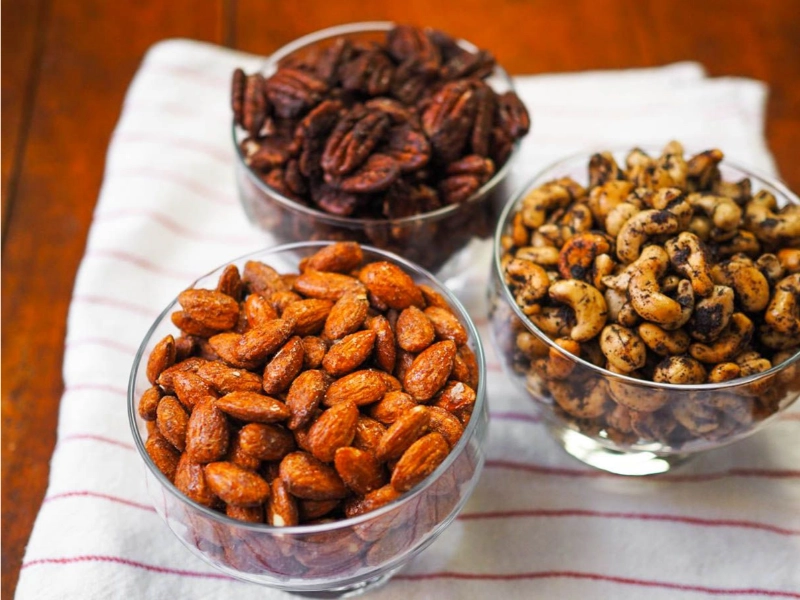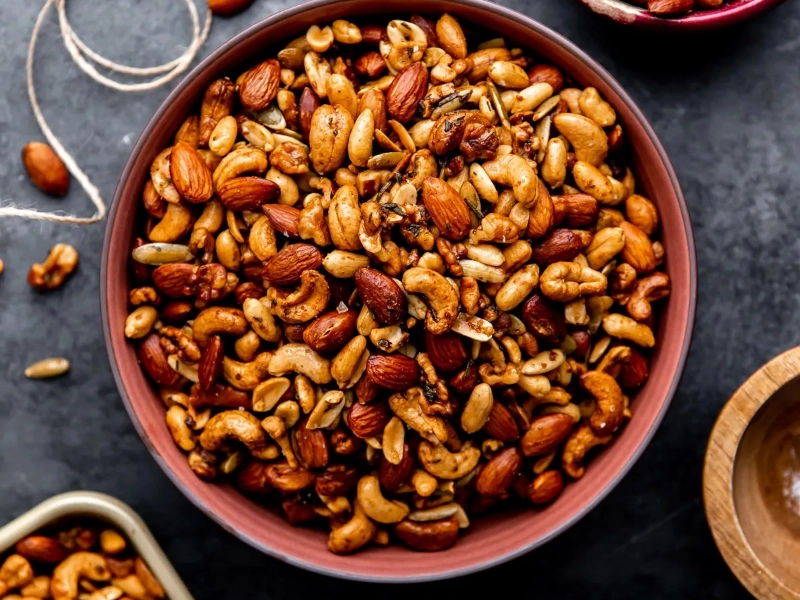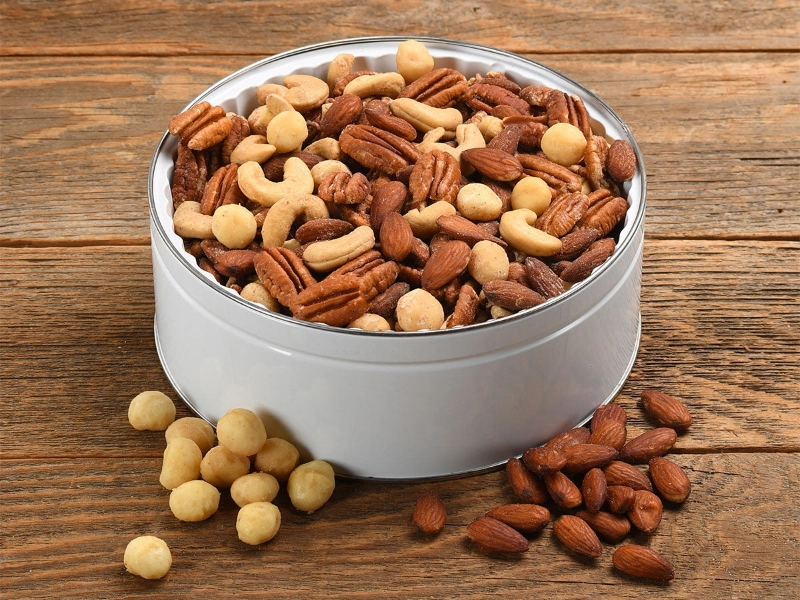Not merely a great snack, nuts are a nutritional powerhouse that can help type 2 diabetes be managed in major part. Packed with good fats, fibre, vitamins, and minerals, nuts can help control blood sugar levels and boost general health. The several ways nuts might help those with type 2 diabetes, their nutritional worth, and useful advice on how to include them into your diet are discussed in this article.
 In a modest quantity, nuts offer a multitude of vital minerals and are rather nutrient-dense. Rich in good monounsaturated and polyunsaturated fats, which help heart health, they Maintaining heart health is really vital for those with type 2 diabetes as they run more danger for cardiovascular problems. Furthermore a great source of dietary fibre, nuts aid to slow down sugar absorption into the bloodstream, so reducing spikes in blood glucose levels.
Nutritional characteristics differ among the several kinds of nuts. For example, walnuts are rich in omega-3 fatty acids; almonds are heavy in vitamin E and magnesium. These minerals enhance general health as well as help control blood sugar. Including a range of nuts in your diet can help you to guarantee a wide spectrum of nutrients supporting diabetic control.
In a modest quantity, nuts offer a multitude of vital minerals and are rather nutrient-dense. Rich in good monounsaturated and polyunsaturated fats, which help heart health, they Maintaining heart health is really vital for those with type 2 diabetes as they run more danger for cardiovascular problems. Furthermore a great source of dietary fibre, nuts aid to slow down sugar absorption into the bloodstream, so reducing spikes in blood glucose levels.
Nutritional characteristics differ among the several kinds of nuts. For example, walnuts are rich in omega-3 fatty acids; almonds are heavy in vitamin E and magnesium. These minerals enhance general health as well as help control blood sugar. Including a range of nuts in your diet can help you to guarantee a wide spectrum of nutrients supporting diabetic control.
 For those with type 2 diabetes, nuts' ability to help control blood sugar levels is among their most important advantages. Healthy fats, fibre, and protein found in nuts taken together help to regulate glycaemic levels. Studies have indicated that eating nuts helps lower fasting blood sugar levels and increase insulin sensitivity—qualities necessary for good management of diabetes.
Stability of blood sugar depends critically on the fibre level in nuts. Because fibre slows down the digestion and absorption of carbohydrates, blood sugar levels rise more slowly following meals. For those with diabetes, this can help avoid the sometimes troublesome abrupt rises and declines in blood sugar. Including nuts into meals or snacks can be a good way to keep steady blood glucose levels all day.
For those with type 2 diabetes, nuts' ability to help control blood sugar levels is among their most important advantages. Healthy fats, fibre, and protein found in nuts taken together help to regulate glycaemic levels. Studies have indicated that eating nuts helps lower fasting blood sugar levels and increase insulin sensitivity—qualities necessary for good management of diabetes.
Stability of blood sugar depends critically on the fibre level in nuts. Because fibre slows down the digestion and absorption of carbohydrates, blood sugar levels rise more slowly following meals. For those with diabetes, this can help avoid the sometimes troublesome abrupt rises and declines in blood sugar. Including nuts into meals or snacks can be a good way to keep steady blood glucose levels all day.
 Managing type 2 diabetes depends on keeping a good weight, hence nuts can be a great friend in this sense. The great fat and protein content of nuts helps people feel full and satisfied following meals, therefore fostering satiety. This can help to lower the risk of overindulging in unhealthy foods and snacks, therefore affecting blood sugar levels.
Though they are calorie-dense, studies have indicated that adding nuts to a balanced diet can result in either weight loss or maintenance. The secret is moderation; a little handful of nuts can have major health advantages without adding to too high calorie consumption. Those with type 2 diabetes can help to manage their weight by selecting nuts as a healthy snack choice and savour a great and pleasant treat.
Managing type 2 diabetes depends on keeping a good weight, hence nuts can be a great friend in this sense. The great fat and protein content of nuts helps people feel full and satisfied following meals, therefore fostering satiety. This can help to lower the risk of overindulging in unhealthy foods and snacks, therefore affecting blood sugar levels.
Though they are calorie-dense, studies have indicated that adding nuts to a balanced diet can result in either weight loss or maintenance. The secret is moderation; a little handful of nuts can have major health advantages without adding to too high calorie consumption. Those with type 2 diabetes can help to manage their weight by selecting nuts as a healthy snack choice and savour a great and pleasant treat.
 People with type 2 diabetes are more likely to have heart disease, so heart health is first concern. Many cardiovascular advantages from nuts help to lower this risk. While raising good cholesterol levels (HDL), the beneficial fats in nuts—especially monounsaturated fats—can help lower bad cholesterol levels (LDL). Improved general heart health and lower risk of cardiovascular problems can follow from this.
Furthermore abundant in antioxidants, nuts help fight oxidative stress and bodily inflammation. Many chronic diseases, including diabetes and heart disease, are caused in part by inflammation over time. Including nuts in your diet will help you take advantage of their anti-inflammatory qualities, therefore supporting heart health and general wellbeing.
People with type 2 diabetes are more likely to have heart disease, so heart health is first concern. Many cardiovascular advantages from nuts help to lower this risk. While raising good cholesterol levels (HDL), the beneficial fats in nuts—especially monounsaturated fats—can help lower bad cholesterol levels (LDL). Improved general heart health and lower risk of cardiovascular problems can follow from this.
Furthermore abundant in antioxidants, nuts help fight oxidative stress and bodily inflammation. Many chronic diseases, including diabetes and heart disease, are caused in part by inflammation over time. Including nuts in your diet will help you take advantage of their anti-inflammatory qualities, therefore supporting heart health and general wellbeing.
Including nuts into your regular diet is simple and flexible. You might eat them whole, sliced, or as nut butter among other ways. While adding a pleasing crunch, adding nuts to salads, yoghurt, or muesli can improve the nutritional worth of these foods. To stifle hunger between meals, think about keeping a small jar of mixed nuts handy for a fast snack. Using nuts in cooking and baking offers still another imaginative approach to enjoy them. While chopped nuts can provide food like stir-fries or baked products structure and taste, ground nuts can be used as a flour alternative for gluten-free diets. Experimenting with several dishes can help you to find fun ways to include nuts in your diet and appreciate their health advantages.
Not all nuts are made equal, hence some may help type 2 diabetes management more than others. Particularly helpful because of their nutritious profiles are almonds, walnuts, pistachios, and pecans. Select unsalted and unflavoured varieties of nuts to cut back on added sweeteners and too much sodium. This will guarantee that, without sacrificing your nutritional goals, you are optimising the health advantages of nuts. And when eating nuts, quantity control is really vital. Though they are healthful, they also pack calories. Usually one ounce, a little handful is a good serving size. You may easily include nuts into your diabetes control strategy by being aware of quantities and selecting the correct kinds of them.